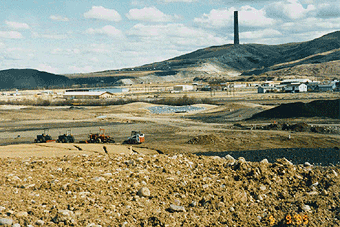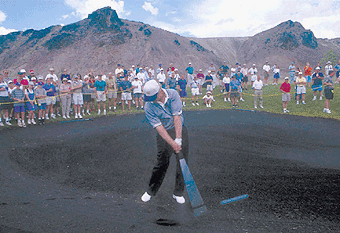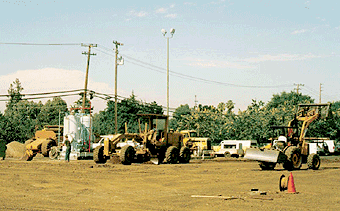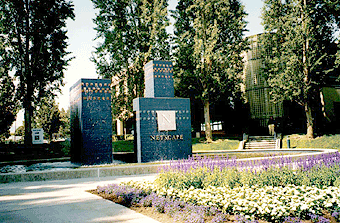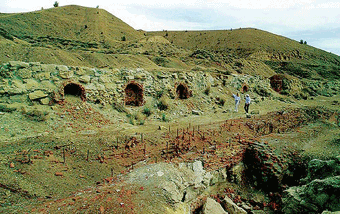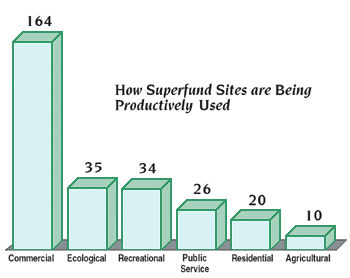| |
||||||
|
||||||
Article |
|
| Reusing Superfund Sites | |
|
|
|
| In California's
Silicon Valley, Netscape Communications opened a new office campus,
allowing the software company to expand its World Headquarters, and
the local community to enjoy the benefits of 1,600 software development
jobs. Across the country in Virginia, two parks are added to the York
County recreational system providing thousands of residents with a
new place to play softball and soccer.
Farther to the south, a critical maintenance and repair center is built for the Dade County, Florida, rail system ensuring fast and reliable train service for over 50,000 daily commuters in the Miami metropolitan area. Up in the Mountain Northwest, outdoor enthusiasts come from miles around to enjoy a 2,500-acre wetlands area in Montana's Warm Springs Ponds which also provides an important habitat for migrating Canada geese and a breeding ground for dozens of songbird species. And in West Dallas, Texas, an abandoned strip mall is renovated and the first major supermarket ever built in the area opens for business. In addition to fulfilling a critical need for the residents of this inner-city neighborhood, the new supermarket serves as a catalyst to bring even more development to this low income community, including the building of public service facilities and hundreds of new homes. |
|
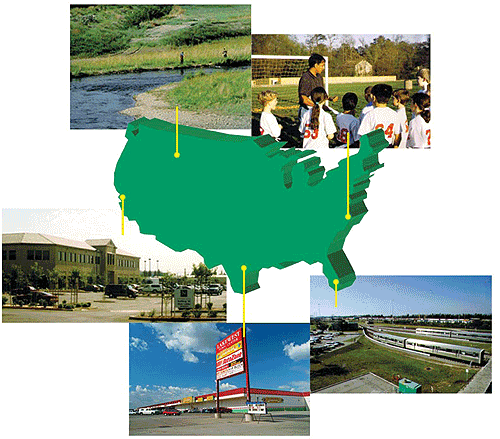
Upper Left: Trout fishing at the Silver Bow Creek/Warm Springs Pond site (Butte, Montana). Upper Right: Children's soccer at the Chisman Creek site (York County, Virginia). Lower Left: Netscape World Headquarters at the Fairchild Semiconductor site (Mountain View, California). Lower Center: New supermarket at the RSR Corp. site (West Dallas, Texas). Lower Right: Commuter trains maintained at the Miami Drum Services site (Dade County, Florida). |
|
Five very different success stories from five different areas of the country. But they have one surprising thing in common. All were built on cleaned up Superfund sites. Many people still think of Superfund sites as permanent toxic wastelands in the middle of their communities. There are vivid memories of more than 500 families having to leave their homes when the entire town of Times Beach, Missouri, had to be closed because of the discovery of dioxin. And in Love Canal, New York, more than 900 families had to be relocated when hazardous wastes leached from an industrial landfill contaminating nearby homes. Superfund evokes images of workers in "moon suits" and areas fenced off with large "Danger–Keep Out" signs. That was the 1980s. Two decades later, much has changed. In Times Beach, 265,000 tons of dioxin-contaminated soil was dug up and incinerated. Thanks to new habitat management practices, Times Beach is now an extensive bird sanctuary and migratory bird waterway. At Love Canal, cleanup activities included demolition of the contaminated houses and construction of a specially designed system that permanently entombs the toxic materials. As a result, all contamination is safely contained. Families are now moving back into the area and more than 200 new homes have been sold. Bird sanctuaries. Revitalized neighborhoods. These are the new images of Superfund. Other images include Jack Nicklaus teeing off at a golf course that he designed at a closed copper smelter in Montana. Or a Home Depot opening at a site that was once a radium processing plant – bringing new jobs and income to a disadvantaged community near downtown Denver. Areas that were once dangerous are now being cleaned up and turned into office parks, playing fields, industrial centers, shopping centers, residential areas, tourist centers, and wetlands. Sites that were once abandoned or underused have now become valuable community resources. Areas that once helped to pull the local economy down are now generating new tax revenue and serving as catalysts for broader revitalization. |
|
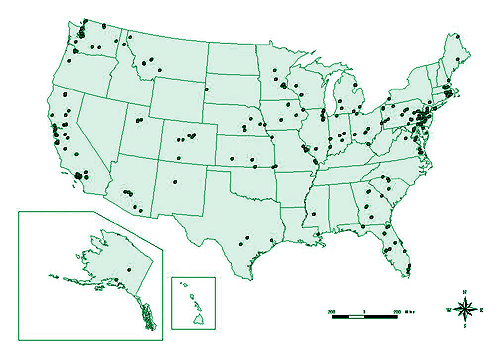 Over 240 sites have been reused and many more are expected to be in use soon. |
|
| There have been more than 240 success stories at Superfund sites in all areas of the country – over 130 of them involving totally new uses for a site. But this is just the beginning. These successes will be repeated at hundreds of other Superfund sites in the next few years. One could be at a site in your community. | |
| back
to top |
|
| How Superfund Sites Have Been Safely and Productively Reused | |
| The stories of successful reuse differ because communities differ. Reuse of each Superfund site begins and ends with the needs of the particular community in which the site is located. | |
|
Golf and Smelter Slag? Nicklaus Shows How It "Works" The Anaconda Smelter was the backbone of the local economy for a century. When it shut down in 1980, hundreds of people were out of work. The smelter also left behind an environmental legacy of more than 1.5 million cubic yards of soil, slag, and flue dust contaminated with heavy metals such as arsenic, cadmium, copper, lead, and zinc. People were worried that Anaconda would turn into an economic ghost town. Rather than suffer this fate, the Anaconda community, ARCO, and EPA formed a partnership – not only to clean up the site – but to preserve its historic significance and allow for redevelopment. They considered a number of options, but one day, Gene Vuckovich, the Anaconda city and county manager, asked: "Why don't you make a golf course out of it?" His proposal was first met with "a few chuckles" and some skepticism, but in time, the partnership agreed. |
|
|
As designer, Nicklaus took advantage of the areas's spectacular mountain vistas and preserved many of the unique historic characteristics of the former smelting site. He used one of those characteristics to create the most distinctive aspect of the course. Nicklaus decided not to fill the bunkers with ordinary white sand, but instead with black "sland" – an inert and harmless sand-like slag left behind by the smelter's furnaces. Besides providing players with the unique challenge of hitting their wayward balls out of "sland" traps, these black bunkers add to the striking visual appeal of the golf course. In the end, the partnership between the people of Anaconda, ARCO, EPA, and Nicklaus created a course that Golf Journal praised as "world class . . . with 18 fascinating holes." |
|
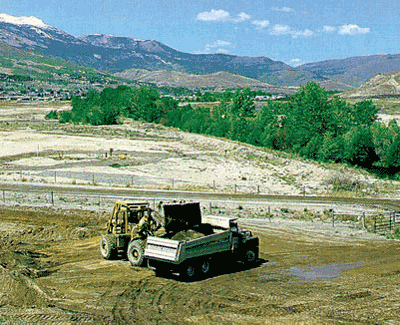 Cleanup of the Anaconda Smelter site paved the way for construction of a world class golf course |
|
|
Internet Communicators Replace Ground Contaminators Mountain View is not a depressed community in need of economic revitalization. Located in the heart of Silicon Valley, Mountain View is at the center of America's high-tech economic boom. Real estate in Mountain View is among the most valuable in the country. All the more reason not to allow 56 acres of that precious real estate to lie idle. The Fairchild Semi-conductor Superfund site was once the home of more than a dozen computer firms that used solvents daily in their manufacturing process. Hundreds of gallons of these solvents were spilled into the soil and groundwater over a 20-year period. In 1981, the State of California discovered contamination in the underlying aquifer that provided drinking water for 270,000 residents.
As the cleanup proceeded, Keenan-Lovewell began plans to build office developments at the former Fairchild site. The first occupant was high-tech giant, Netscape Communications. Netscape used this property to add a new facility to its World Headquarters – an office complex that resembles a park or a college campus more than the workplace of 1,600 top executives, programmers, marketers, and testers. Complete with cascading fountains and acres of lush greenery, this once-contaminated industrial site now adds beauty to the Mountain View community while also adding substantial income to the local economy. These are the stories of Anaconda and Mountain View. And their stories are being repeated at communities all over the country. Properties that once lay idle – drains on the local economies – are now being put back into productive use. Areas that were once dangerous and off-limits are now places where people can safely work and play. These are only some of the benefits for a community that decides to redevelop and reuse a Superfund site. |
|
| back
to top |
|
| How Communities Have Benefited From Reusing Superfund Sites | |
| More High-Tech
Development in Mountain View The benefits to Mountain View in redeveloping the Fairchild site were immediate. The office campus at the former Superfund site is an expansion of Netscape's World Headquarters. The high-tech executives and employees who work at the Netscape campus collectively earn more than $153 million annually infusing over $122 million of personal spending into the economy and providing more than $11 million in local and state taxes. However, the benefits to Mountain View in redeveloping the Fairchild site do not stop with Netscape. Other firms are either leasing space or building their own office developments on the former Superfund site. The firms read like a Who's Who of the "old" and "new" economies: America Online, Veritas Software, Hewlett-Packard, Open TV, Nokia, Micro Focus, Synopsys, and KPMG Peat Marwick. By 1999, all the available office space had been leased and most of the remaining property was at some stage of development. |
|
| A New Sense
of Pride in Anaconda In Anaconda, the benefits of reuse are harder to measure, but just as important. Anaconda was historically a one-factory town and that factory closed down. Unemployment was high and many in the community worried that their town would not survive. The Old Works Golf Course not only provides a new place for the residents of Anaconda to exercise and have fun – but has also created a new sense of pride in the community. What's more, the golf course is becoming a tourist magnet. People come from miles around because they have heard about the unique and beautiful Jack Nicklaus- designed course. They come to play golf – and find out that the area also offers excellent skiing, fishing, hiking, and hunting. So they come back.
New jobs. New recreational opportunities. Higher property values. More income to the community. A new sense of pride. These are just some of the benefits of reusing Superfund sites. |
|
|
New Uses for Sites Around the Country
|
|
|
|
| One New Use
Leads to Another In Anaconda, the golf course may be categorized as recreational use, but simply calling it "recreational" tells only part of the story. Golfers who come to the Old Works pay a variety of charges, such as "greens" fees, rentals, and concessions. Also, since many of those golfers come from out of town, they stay at local motels and eat at local restaurants. All this generates income for the community. So this recreational use also provides new commercial opportunities. And, in the case of Anaconda, these new recreational and commercial opportunities caused the community to have a new respect for the area's natural surroundings. In Mountain View, the commercial redevelopment of the former Fairchild site is just one part of a larger plan by the city to link a nearby residential community with the high-tech job center that now occupies the former Superfund site. Plans are underway to build light rail stations, parks, biking trails, and open spaces so that there will be connections (most of them walkable) between where the residents of Mountain View live, work, and play. Each community decides how far and how wide the benefits of reusing a Superfund site will extend. The particular uses will depend on the needs and desires of your community. |
|
| back
to top |
|
| Where Communities Can Find Out More About Reuse | |
| As Charlie Coleman,
the EPA Project Manager for the Anaconda site, put it: Superfund reuse
is "win-win-win." All the parties came out ahead in the
Anaconda agreement – and this same all-around success is possible
whenever a Superfund site is reused. Reuse helps to protect human
health and the environment. It makes land productive (and sometimes
beautiful) again. And reuse gives communities a new resource to enhance
the ways they live, work, and play.
There have been more than 240 Superfund site use success stories. Hundreds more are expected in the next few years. To help your community become one of these success stories, here is where you can find out more information about the subjects discussed in this article: General Sources of Information on Superfund Reuse The Superfund Redevelopment Initiative website For questions about reuse, either call the Superfund Hotline at 1-800-424-9346 or send an e-mail to reuse.info@epa.gov. Sources of Specific Information on Topics Discussed in This Article: How Superfund Sites Have Been Safely and Productively Reused Remediation Technologies Screeing Matrix and Reference Guide |
|
| Adapted from Enviromental Protection Ageny's Superfund Redevelopment Program Web site, October 2003. | |
| back
to top |
